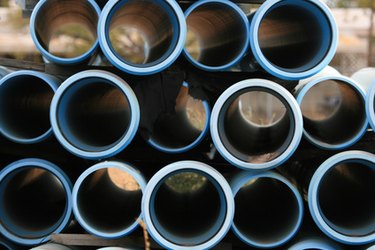Sewer pipes usually do not need to be insulated as they do not hold standing water. However, in extremely cold regions where the line is exposed or runs close to an uninsulated wall adding insulation is warranted. Adding insulation will also deaden the sound of running water if the pipe runs close to living areas. When insulating PVC sewer pipes standard fiberglass wall insulation will offer more protection than polyethylene foam insulation.

Video of the Day
Things You'll Need
R16 Fiberglass Wall Insulation
Plastic Sheeting
Gloves
Tape Measure
Utility Knife
Duct Tape
Step 1
Measure the length of the run of sewer pipe and cut a length of insulation to match.
Video of the Day
Step 2
Lay a strip of insulation along the top of the PVC sewer pipe.
Step 3
Pull the edges of the insulation around the pipe until they overlap each other. Tack the edges of the insulation to the pipe with duct tape. Once the pipe is covered with insulation run a piece of tape along the entire length of the seam or edges of the insulation. Do not compress the insulation as it is the air spaces inside the insulation fibers that do the actual "insulating."
Step 4
Wrap the insulation with plastic sheeting to prevent moisture buildup and seal closed the edges of the plastic by running a piece of tape along its entire length.
Tip
Always wear gloves when handling fiberglass insulation. It can irritate the skin.